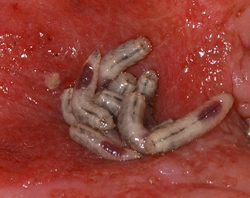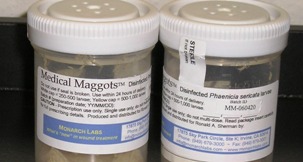Medical Maggots
Biotherapy:
Biotherapy is using live organisms to treat
illness. Some examples of this include leech therapy,
bee venom therapy, and maggot therapy. The overall goal of
maggot therapy is to remove dead tissue safely from a patient.
Maggot therapy was initially studied when soldiers were found
with maggot infestations in their wounds. They noticed that
these soilders wounds would heal much better after the
infestation of the maggots.
However by using the wrong species of fly it was found that it can
damage
the living tissue.
Maggots:
Lucilia sericata is one of the most commonly
used blow flies for maggot therapy. Today it is used to treat
different types of skin and soft tissue wounds. The maggots have
been known to eliminate odor and destroy some tissue of malignant tumors. If a wound is life threatening,
maggot therapy is not used and doctors will try surgery. The
number of maggots that are applied to a wound all depends on the
age and size of the maggot, amount of necrotic tissue, and the
size of the wound. Once they are placed on the wound the doctor
will then wrap the area with proper dressings to ensure that the
maggots will not escape. The larvae will be removed from the
wound up to three days later.
some tissue of malignant tumors. If a wound is life threatening,
maggot therapy is not used and doctors will try surgery. The
number of maggots that are applied to a wound all depends on the
age and size of the maggot, amount of necrotic tissue, and the
size of the wound. Once they are placed on the wound the doctor
will then wrap the area with proper dressings to ensure that the
maggots will not escape. The larvae will be removed from the
wound up to three days later.
How it works:
Maggots remove the debris and infection from a
patient which will then help the body heal the wound. In 1935,
Simmons it is reported that the antimicrobial activity of
medicinal maggots secretions have an ability to kill strains of
Staphylococcus aureus and Streptococcus sp.
Maggots excrete products that inhibit growth of microbes and
will help stimulate healthy tissue growth. It is very important
to make sure that the maggots being used are germ-free. There
have been cases where patients will develop bloodstream
infections during maggot therapy
because the maggots were not sterile before the application. The
procedure of making sure that maggots are not contaminated has
been improved. Doctors can now ensure that they are placing
sterile maggots on patients because of the tests that they must
past. The maggots will be placed on a blood agar plate which can
detect if the maggot is contaminated with
bacteria or fungi.
Also a random sample of maggots will be checked for pathogens
before being delivered to a hospital. Finally many doctors will
take a swab of the maggots before application to further ensure
the safety of them. This is why it is important that if you are
considering maggot therapy you should do it in a safe medical
setting with a certified doctor.
hospital. Finally many doctors will
take a swab of the maggots before application to further ensure
the safety of them. This is why it is important that if you are
considering maggot therapy you should do it in a safe medical
setting with a certified doctor.
Some people might quiver and squirm at the idea of
maggots crawling on their bodies to help heal their wounds. This
has prevented many people from choosing this therapy as a
possible treatment. With an increase in antibiotic-resistant
bacteria, maggot therapy might be the only thing that will help
heal a wound. Education on the benefits of Lucilia sericata
will hopefully increase the popularity of maggot therapy and
biotherapy in general.
Check out this Youtube video on
Maggot Medicine!!!
Take a look at how Lucilia sericata are involved with
forensic science